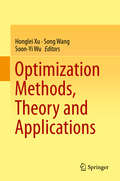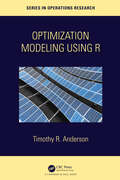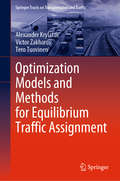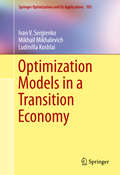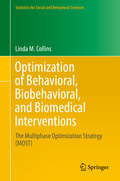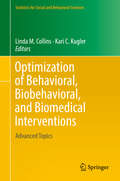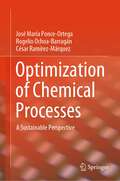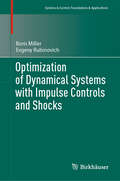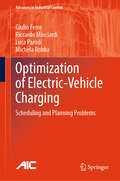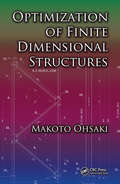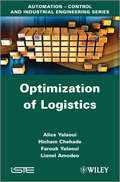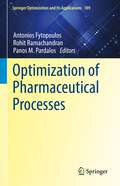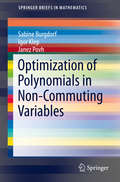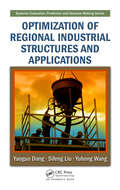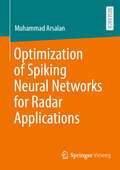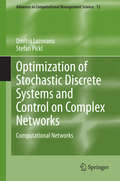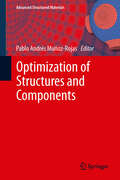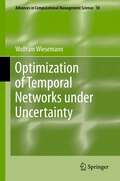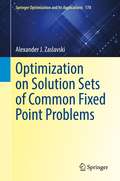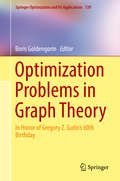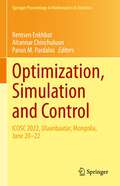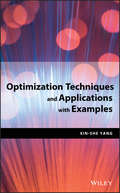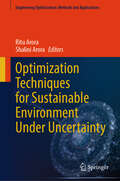- Table View
- List View
Optimization Methods, Theory and Applications
by Honglei Xu Song Wang Soon-Yi WuThis book presents the latest research findings and state-of-the-art solutions on optimization techniques and provides new research direction and developments. Both the theoretical and practical aspects of the book will be much beneficial to experts and students in optimization and operation research community. It selects high quality papers from The International Conference on Optimization: Techniques and Applications (ICOTA2013). The conference is an official conference series of POP (The Pacific Optimization Research Activity Group; there are over 500 active members). These state-of-the-art works in this book authored by recognized experts will make contributions to the development of optimization with its applications.
Optimization Modelling Using R (Chapman & Hall/CRC Series in Operations Research)
by Timothy R. AndersonThis book covers using R for doing optimization, a key area of operations research, which has been applied to virtually every industry. The focus is on linear and mixed integer optimization. It uses an algebraic modeling approach for creating formulations that pairs naturally with an algebraic implementation in R. With the rapid rise of interest in data analytics, a data analytics platform is key. Working technology and business professionals need an awareness of the tools and language of data analysis. R reduces the barrier to entry for people to start using data analytics tools. Philosophically, the book emphasizes creating formulations before going intoimplementation. Algebraic representation allows for clear understanding and generalizationof large applications, and writing formulations is necessary to explain and convey the modeling decisions made. Appendix A introduces R. Mathematics is used at the level of subscripts and summations Refreshers are provided in Appendix B. This book: • Provides and explains code so examples are relatively clear and self-contained.• Emphasizes creating algebraic formulations before implementing.• Focuses on application rather than algorithmic details.• Embodies the philosophy of reproducible research.• Uses open-source tools to ensure access to powerful optimization tools.• Promotes open-source: all materials are available on the author’s github repository.• Demonstrates common debugging practices with a troubleshooting emphasis specific to optimization modeling using R.• Provides code readers can adapt to their own applications.This book can be used for graduate and undergraduate courses for students without a background in optimization and with varying mathematical backgrounds.
Optimization Models
by Giuseppe C. Calafiore Laurent El GhaouiEmphasizing practical understanding over the technicalities of specific algorithms, this elegant textbook is an accessible introduction to the field of optimization, focusing on powerful and reliable convex optimization techniques. Students and practitioners will learn how to recognize, simplify, model and solve optimization problems - and apply these principles to their own projects. A clear and self-contained introduction to linear algebra demonstrates core mathematical concepts in a way that is easy to follow, and helps students to understand their practical relevance. Requiring only a basic understanding of geometry, calculus, probability and statistics, and striking a careful balance between accessibility and rigor, it enables students to quickly understand the material, without being overwhelmed by complex mathematics. Accompanied by numerous end-of-chapter problems, an online solutions manual for instructors, and relevant examples from diverse fields including engineering, data science, economics, finance, and management, this is the perfect introduction to optimization for undergraduate and graduate students.
Optimization Models and Methods for Equilibrium Traffic Assignment (Springer Tracts on Transportation and Traffic #15)
by Alexander Krylatov Victor Zakharov Tero TuovinenThis book is focused on the discussion of the traffic assignment problem, the mathematical and practical meaning of variables, functions and basic principles. This work gives information about new approaches, methods and algorithms based on original methodological technique, developed by authors in their publications for the past several years, as well as corresponding prospective implementations. The book may be of interest to a wide range of readers, such as civil engineering students, traffic engineers, developers of traffic assignment algorithms etc. The obtained results here are to be used in both practice and theory. This book is devoted to the traffic assignment problem, formulated in a form of nonlinear optimization program. The most efficient solution algorithms related to the problem are based on its structural features and practical meaning rather than on standard nonlinear optimization techniques or approaches. The authors have carefully considered the meaning of the traffic assignment problem for efficient algorithms development.
Optimization Models in a Transition Economy
by Ivan V. Sergienko Mikhail Mikhalevich Ludmilla KoshlaiThis book opens new avenues in understanding mathematical models within the context of a transition economy. The exposition lays out the methods for combining different mathematical structures and tools to effectively build the next model that will accurately reflect real world economic processes. Mathematical modeling of weather phenomena allows us to forecast certain essential weather parameters without any possibility of changing them. By contrast, modeling of transition economies gives us the freedom to not only predict changes in important indexes of all types of economies, but also to influence them more effectively in the desired direction. Simply put: any economy, including a transitional one, can be controlled. This book is useful to anyone who wants to increase profits within their business, or improve the quality of their family life and the economic area they live in. It is beneficial for undergraduate and graduate students specializing in the fields of Economic Informatics, Economic Cybernetics, Applied Mathematics and Large Information Systems, as well as for professional economists, and employees of state planning and statistical organizations.
Optimization of Behavioral, Biobehavioral, and Biomedical Interventions: The Multiphase Optimization Strategy (MOST) (Statistics for Social and Behavioral Sciences)
by Linda M. CollinsThis book presents a framework for development, optimization, and evaluation of behavioral, biobehavioral, and biomedical interventions. Behavioral, biobehavioral, and biomedical interventions are programs with the objective of improving and maintaining human health and well-being, broadly defined, in individuals, families, schools, organizations, or communities. These interventions may be aimed at, for example, preventing or treating disease, promoting physical and mental health, preventing violence, or improving academic achievement. This volume introduces the multiphase optimization strategy (MOST), pioneered at The Methodology Center at the Pennsylvania State University, as an alternative to the classical approach of relying solely on the randomized controlled trial (RCT). MOST borrows heavily from perspectives taken and approaches used in engineering, and also integrates concepts from statistics and behavioral science, including the RCT. As described in detail in this book, MOST consists of three phases: preparation, in which the conceptual model underlying the intervention is articulated; optimization, in which experimentation is used to gather the information necessary to identify the optimized intervention; and evaluation, in which the optimized intervention is evaluated in a standard RCT. Through numerous examples, the book demonstrates that MOST can be used to develop interventions that are more effective, efficient, economical, and scalable.Optimization of Behavioral, Biobehavioral, and Biomedical Interventions: The Multiphase Optimization Strategy is the first book to present a comprehensive introduction to MOST. It will be an essential resource for behavioral, biobehavioral, and biomedical scientists; statisticians, biostatisticians, and analysts working in epidemiology and public health; and graduate-level courses in development and evaluation of interventions.
Optimization of Behavioral, Biobehavioral, and Biomedical Interventions: Advanced Topics (Statistics for Social and Behavioral Sciences)
by Linda M. Collins Kari C. KuglerBehavioral, biobehavioral, and biomedical interventions are programs with the objective of improving and maintaining human health and well-being, broadly defined, in individuals, families, schools, organizations, or communities. These interventions may be aimed at, for example, preventing or treating disease, promoting physical and mental health, preventing violence, or improving academic achievement. This book provides additional information on a principled empirical framework for developing interventions that are more effective, efficient, economical, and scalable. This framework is introduced in the monograph, "Optimization of Behavioral, Biobehavioral, and Biomedical Interventions: The Multiphase Optimization Strategy (MOST)" by Linda M. Collins (Springer, 2018). The present book is focused on advanced topics related to MOST. The chapters, all written by experts, are devoted to topics ranging from experimental design and data analysis to development of a conceptual model and implementation of a complex experiment in the field. Intervention scientists who are preparing to apply MOST will find this book an important reference and guide for their research. Fields to which this work pertains include public health (medicine, nursing, health economics, implementation sciences), behavioral sciences (psychology, criminal justice), statistics, and education.
Optimization of Chemical Processes: A Sustainable Perspective
by José María Ponce-Ortega Rogelio Ochoa-Barragán César Ramírez-MárquezThis textbook introduces readers to a comprehensive framework for the application of deterministic optimization strategies in the field of chemical processes, with a strong emphasis on sustainability.The book establishes a vital connection between fundamental deterministic optimization principles, optimization tools, and real-world application instances, all within the context of environmentally responsible practices. The approach put forth in this book is exceptionally versatile, allowing for the use of many optimization software and deterministic techniques.Contained in the book are many fundamental optimization concepts, encompassing linear programming, nonlinear programming, integer programming, and multi-objective optimization, all tailored to promote sustainable decision-making. Furthermore, the book provides practical examples illustrating the application of these techniques within sustainable chemical processes as tutorials.The textbook also explores the utilization of popular optimization software platforms such as GAMS, MATLAB, and Python, demonstrating how these tools can be leveraged for eco-friendly process optimization. Through this comprehensive framework, readers can not only acquire the skills needed to optimize a wide range of processes but also learn how to do so with sustainability at the forefront of their considerations. This approach streamlines the optimization process, eliminating unnecessary complications along the way and ensuring that environmental and ethical considerations are integral to the decision-making process.
Optimization of Dynamical Systems with Impulse Controls and Shocks (Systems & Control: Foundations & Applications)
by Boris Miller Evgeny RubinovichThis text explores the state-of-the-art in the rapidly developing theory of impulse control and introduces the theory of singular space-time transformations, a new method for studying shock mechanical systems. Two approaches in the theory of impulse control are presented: The first, more traditional approach defines the impulsive action as a discontinuity of phase coordinates depending on the current time, the state preceding the action, and its magnitude. The second requires the use of modern methods for describing dynamical systems - differential equations with measures. The impulse is treated as an idealization of a very short action of high magnitude, which produces an almost abrupt change of phase coordinates. The relation between these two approaches is also discussed, and several applications, both traditional and emerging, are considered. This text is intended for graduate students and researchers in control engineering and optimal control theory for dynamical systems. Readers are assumed to be familiar with the theory of ODEs, optimal control, and functional analysis, though an appendix is included that covers many of the necessary mathematical concepts.
Optimization of Electric-Vehicle Charging: Scheduling and Planning Problems (Advances in Industrial Control)
by Giulio Ferro Riccardo Minciardi Luca Parodi Michela RobbaThis book provides models and methods for the optimal management of electrical vehicles through an interdisciplinary approach that brings together knowledge from the sectors of transportation, manufacturing and smart grids. Optimization of Electric-Vehicle Charging explores several optimization models for the scheduling of electric vehicles in a smart grid. Both discrete-time and discrete-event approaches are considered to minimize tardiness, charging and production costs, on the basis of information like release time, due date, deadline, energy request, and availability of energy generated from renewable sources. Transportation demand is assessed, as well as user-equilibrium-based approaches, for the location of charging stations and for the assignment of users to multiple charging stations. Employing illustrations, tables and examples to elucidate the ideas presented, this book will be of value to researchers and practitioners in the fields of electrical engineering and transportation, as well as to graduate and PhD students.
Optimization of Finite Dimensional Structures
by Makoto OhsakiOriginally developed for mechanical and aeronautical engineering, structural optimization is not so easily applied to civil and architectural engineering, as structures in these fields are not mass products, but more often unique structures planned in accordance with specific design requirements. The shape and geometry of such structures are determ
Optimization of Integer/Fractional Order Chaotic Systems by Metaheuristics and their Electronic Realization
by Esteban Tlelo-Cuautle Alejandro Silva-Juárez Luis Gerardo de la Fraga Omar Guillén Guillén-FernándezMathematicians have devised different chaotic systems that are modeled by integer or fractional-order differential equations, and whose mathematical models can generate chaos or hyperchaos. The numerical methods to simulate those integer and fractional-order chaotic systems are quite different and their exactness is responsible in the evaluation of characteristics like Lyapunov exponents, Kaplan-Yorke dimension, and entropy. One challenge is estimating the step-size to run a numerical method. It can be done analyzing the eigenvalues of self-excited attractors, while for hidden attractors it is difficult to evaluate the equilibrium points that are required to formulate the Jacobian matrices. Time simulation of fractional-order chaotic oscillators also requires estimating a memory length to achieve exact results, and it is associated to memories in hardware design. In this manner, simulating chaotic/hyperchaotic oscillators of integer/fractional-order and with self-excited/hidden attractors is quite important to evaluate their Lyapunov exponents, Kaplan-Yorke dimension and entropy. Further, to improve the dynamics of the oscillators, their main characteristics can be optimized applying metaheuristics, which basically consists of varying the values of the coefficients of a mathematical model. The optimized models can then be implemented using commercially available amplifiers, field-programmable analog arrays (FPAA), field-programmable gate arrays (FPGA), microcontrollers, graphic processing units, and even using nanometer technology of integrated circuits. The book describes the application of different numerical methods to simulate integer/fractional-order chaotic systems. These methods are used within optimization loops to maximize positive Lyapunov exponents, Kaplan-Yorke dimension, and entropy. Single and multi-objective optimization approaches applying metaheuristics are described, as well as their tuning techniques to generate feasible solutions that are suitable for electronic implementation. The book details several applications of chaotic oscillators such as in random bit/number generators, cryptography, secure communications, robotics, and Internet of Things.
Optimization of Logistics
by Alice Yalaoui Hicham Chehade Farouk Yalaoui Lionel AmodeoThis book aims to help engineers, Masters students and young researchers to understand and gain a general knowledge of logistic systems optimization problems and techniques, such as system design, layout, stock management, quality management, lot-sizing or scheduling. It summarizes the evaluation and optimization methods used to solve the most frequent problems. In particular, the authors also emphasize some recent and interesting scientific developments, as well as presenting some industrial applications and some solved instances from real-life cases.Performance evaluation tools (Petri nets, the Markov process, discrete event simulation, etc.) and optimization techniques (branch-and-bound, dynamic programming, genetic algorithms, ant colony optimization, etc.) are presented first. Then, new optimization methods are presented to solve systems design problems, layout problems and buffer-sizing optimization. Forecasting methods, inventory optimization, packing problems, lot-sizing quality management and scheduling are presented with examples in the final chapters.
Optimization of Pharmaceutical Processes (Springer Optimization and Its Applications #189)
by Antonios Fytopoulos Rohit Ramachandran Panos M. PardalosOptimization of Pharmaceutical Processes presents contributions from leading authorities in the fields of optimization and pharmaceutical manufacturing. Formulated within structured frameworks, practical examples and applications are given as guidance to apply optimization techniques to most aspects of pharmaceutical processes from design, to lab and pilot scale, and finally to manufacturing. The increasing demand for better quality, higher yield, more efficient-optimized and green pharmaceutical processes, indicates that optimal conditions for production must be applied to achieve simplicity, lower costs and superior yield. The application of such methods in the pharmaceutical industry is not trivial. Quality of the final product is of major importance to human health and the need for deep knowledge of the process parameters and the optimization of the processes are imperative. The volume, which includes new methods as well as review contributions will benefit a wide readership including engineers in pharmaceuticals, chemical, biological, to name just a few.
Optimization of Polynomials in Non-Commuting Variables
by Sabine Burgdorf Igor Klep Janez PovhThis bookpresents recent results on positivity and optimization of polynomials innon-commuting variables. Researchers in non-commutative algebraic geometry,control theory, system engineering, optimization, quantum physics andinformation science will find the unified notation and mixture of algebraicgeometry and mathematical programming useful. Theoretical results are matchedwith algorithmic considerations; several examples and information on how to useNCSOStools open source package to obtain the results provided. Results arepresented on detecting the eigenvalue and trace positivity of polynomials innon-commuting variables using Newton chip method and Newton cyclic chip method,relaxations for constrained and unconstrained optimization problems, semidefiniteprogramming formulations of the relaxations and finite convergence of thehierarchies of these relaxations, and the practical efficiency of algorithms.
Optimization of Regional Industrial Structures and Applications (Systems Evaluation, Prediction, and Decision-Making)
by Yaoguo Dang Sifeng Liu Yuhong WangBased on research projects supported by the National Natural Science Foundation of China and Nanjing University of Aeronautics and Astronautics, Optimization of Regional Industrial Structures and Applications provides an authoritative introduction to and survey of the cutting-edge research and applications in industrial structure optimization. Empl
Optimization of Spiking Neural Networks for Radar Applications
by Muhammad ArsalanThis book offers a comprehensive exploration of the transformative role that edge devices play in advancing Internet of Things (IoT) applications. By providing real-time processing, reduced latency, increased efficiency, improved security, and scalability, edge devices are at the forefront of enabling IoT growth and success. As the adoption of AI on the edge continues to surge, the demand for real-time data processing is escalating, driving innovation in AI and fostering the development of cutting-edge applications and use cases. Delving into the intricacies of traditional deep neural network (deepNet) approaches, the book addresses concerns about their energy efficiency during inference, particularly for edge devices. The energy consumption of deepNets, largely attributed to Multiply-accumulate (MAC) operations between layers, is scrutinized. Researchers are actively working on reducing energy consumption through strategies such as tiny networks, pruning approaches, and weight quantization. Additionally, the book sheds light on the challenges posed by the physical size of AI accelerators for edge devices. The central focus of the book is an in-depth examination of SNNs' capabilities in radar data processing, featuring the development of optimized algorithms.
Optimization of Stochastic Discrete Systems and Control on Complex Networks
by Dmitrii Lozovanu Stefan PicklThis book presents the latest findings on stochastic dynamic programming models and on solving optimal control problems in networks. It includes the authors' new findings on determining the optimal solution of discrete optimal control problems in networks and on solving game variants of Markov decision problems in the context of computational networks. First, the book studies the finite state space of Markov processes and reviews the existing methods and algorithms for determining the main characteristics in Markov chains, before proposing new approaches based on dynamic programming and combinatorial methods. Chapter two is dedicated to infinite horizon stochastic discrete optimal control models and Markov decision problems with average and expected total discounted optimization criteria, while Chapter three develops a special game-theoretical approach to Markov decision processes and stochastic discrete optimal control problems. In closing, the book's final chapter is devoted to finite horizon stochastic control problems and Markov decision processes. The algorithms developed represent a valuable contribution to the important field of computational network theory.
Optimization of Structures and Components
by Pablo Andrés Muñoz-RojasWritten by an international group of active researchers in the field, this volume presents innovative formulations and applied procedures for sensitivity analysis and structural design optimization. Eight chapters discuss subjects ranging from recent developments in the determination and application of topological gradients, to the use of evolutionary algorithms and meta-models to solve practical engineering problems. With such a comprehensive set of contributions, the book is a valuable source of information for graduate students and researchers entering or working in the matter.
Optimization of Temporal Networks under Uncertainty
by Wolfram WiesemannMany decision problems in Operations Research are defined on temporal networks, that is, workflows of time-consuming tasks whose processing order is constrained by precedence relations. For example, temporal networks are used to model projects, computer applications, digital circuits and production processes. Optimization problems arise in temporal networks when a decision maker wishes to determine a temporal arrangement of the tasks and/or a resource assignment that optimizes some network characteristic (e.g. the time required to complete all tasks). The parameters of these optimization problems (e.g. the task durations) are typically unknown at the time the decision problem arises. This monograph investigates solution techniques for optimization problems in temporal networks that explicitly account for this parameter uncertainty. We study several formulations, each of which requires different information about the uncertain problem parameters.
Optimization on Solution Sets of Common Fixed Point Problems (Springer Optimization and Its Applications #178)
by Alexander J. ZaslavskiThis book is devoted to a detailed study of the subgradient projection method and its variants for convex optimization problems over the solution sets of common fixed point problems and convex feasibility problems. These optimization problems are investigated to determine good solutions obtained by different versions of the subgradient projection algorithm in the presence of sufficiently small computational errors. The use of selected algorithms is highlighted including the Cimmino type subgradient, the iterative subgradient, and the dynamic string-averaging subgradient. All results presented are new. Optimization problems where the underlying constraints are the solution sets of other problems, frequently occur in applied mathematics. The reader should not miss the section in Chapter 1 which considers some examples arising in the real world applications. The problems discussed have an important impact in optimization theory as well. The book will be useful for researches interested in the optimization theory and its applications.
Optimization Problems in Graph Theory: In Honor of Gregory Z. Gutin's 60th Birthday (Springer Optimization and Its Applications #139)
by Boris GoldengorinThis book presents open optimization problems in graph theory and networks. Each chapter reflects developments in theory and applications based on Gregory Gutin’s fundamental contributions to advanced methods and techniques in combinatorial optimization. Researchers, students, and engineers in computer science, big data, applied mathematics, operations research, algorithm design, artificial intelligence, software engineering, data analysis, industrial and systems engineering will benefit from the state-of-the-art results presented in modern graph theory and its applications to the design of efficient algorithms for optimization problems. Topics covered in this work include:· Algorithmic aspects of problems with disjoint cycles in graphs· Graphs where maximal cliques and stable sets intersect· The maximum independent set problem with special classes· A general technique for heuristic algorithms for optimization problems · The network design problem with cut constraints· Algorithms for computing the frustration index of a signed graph· A heuristic approach for studying the patrol problem on a graph· Minimum possible sum and product of the proper connection number· Structural and algorithmic results on branchings in digraphs · Improved upper bounds for Korkel--Ghosh benchmark SPLP instances
Optimization, Simulation and Control: ICOSC 2022, Ulaanbaatar, Mongolia, June 20–22 (Springer Proceedings in Mathematics & Statistics #434)
by Rentsen Enkhbat Altannar Chinchuluun Panos M. PardalosThis volume gathers selected, peer-reviewed works presented at the 7th International Conference on Optimization, Simulation and Control, ICOSC 2022, held at the National University of Mongolia, Ulaanbaatar, June 20–22, 2022. Topics covered include (but are not limited to) mathematical programming; network, global, linear, nonlinear, parametric, stochastic, and multi-objective optimization; control theory; biomathematics; and deep and machine learning, to name a few. Held every three years since 2002, the ICOSC conference has become a traditional gathering for experienced and young researchers in optimization and control to share recent findings in these fields and discuss novel applications in myriad sectors. Researchers and graduate students in the fields of mathematics, engineering, and computer science can greatly benefit from this book, which can also be enjoyed by advanced practitioners in research laboratories and the industry. The 2022 edition of the ICOSC conference was sponsored by the Mongolian Academy of Sciences, the National University of Mongolia and the German-Mongolian Institute for Resources and Technology.
Optimization Techniques and Applications with Examples
by Xin-She YangA guide to modern optimization applications and techniques in newly emerging areas spanning optimization, data science, machine intelligence, engineering, and computer sciences Optimization Techniques and Applications with Examples introduces the fundamentals of all the commonly used techniques in optimization that encompass the broadness and diversity of the methods (traditional and new) and algorithms. <p><p> The author—a noted expert in the field—covers a wide range of topics including mathematical foundations, optimization formulation, optimality conditions, algorithmic complexity, linear programming, convex optimization, and integer programming. In addition, the book discusses artificial neural network, clustering and classifications, constraint-handling, queueing theory, support vector machine and multi-objective optimization, evolutionary computation, nature-inspired algorithms and many other topics. <p> Designed as a practical resource, all topics are explained in detail with step-by-step examples to show how each method works. The book’s exercises test the acquired knowledge that can be potentially applied to real problem solving. By taking an informal approach to the subject, the author helps readers to rapidly acquire the basic knowledge in optimization, operational research, and applied data mining.
Optimization Techniques for Sustainable Environment Under Uncertainty (Engineering Optimization: Methods and Applications)
by Ritu Arora Shalini AroraThe book's objective is to develop mathematical structures that can be applied to real-life problems with sustainable goals. It focuses on the impact of sustainable living on social, economic, and environmental aspects, aiming to create optimization techniques that minimize emissions and maximize green energy. These optimization problems may include sustainable transport, cities, economic development, living, and tourism. The book brings together researchers, academics, and professionals from various fields to find optimal or satisfactory solutions for various environmentally friendly sustainable problems. It aims to achieve this not only with existing optimization techniques, but also with novel approaches such as lexicographic optimization, heuristic approaches, DEA, and genetic algorithms. The goal is to develop practical algorithms and methods applicable to these problems under uncertain circumstances and explore the potential for improving the efficiency of existing algorithms.
